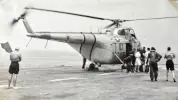Introduction
During 1953 and 1954, HMS Warrior was home to 811 Naval Air Squadron which flew Sea Furies and 825 NAS which flew Firefly AS.5s. The ship could support up to 48 aircraft.
Most of the following photos were taken from my dad's photo albums but in November 2000, Tony Pearce who was one of the two onboard meteorologists, emailed me saying that there were two photographers, Kingsley Jones and Norman Ford, on HMS Warrior. it is more than likely that these took the original photographs.
I also need to thank Albert Gauthier whose father served on HMCS Warrior from her launch in 1944 to the end of the war. Taff Webb sent some very nice photographs. His father, Rowland Victor Webb, served on HMS Warrior during 1953 and 1954. I also need to thank Vic Flintham for identifying the aircraft. Vic is a post-war aviation historian and author. His original site can be found on the Internet Archive, and here is his current site.
HMCS Warrior
HMS Warrior was laid down on December 12, 1942 and launched on May 20, 1944. It was commissioned into the Royal Navy on January 24, 1946 and the Royal Canadian Navy as HMCS Warrior, on March 14, 1946, where it remained until November 1948 before returning to the Royal Navy.

A post-war Firefly Mk I. Photo very kindly sent by Albert Gauthier
In December 2002, Albert Gauthier sent me the above great photo of HMCS Warrior. His dad served on her from her launch in 1944 to the end of the war. Albert wrote:
My dad joined the Canadian Navy in 1943, immediately after turning 18 years old. He was immediately shipped to Halifax, Nova Scotia and shortly thereafter, shipped to London and a place called Macrihanish in Scotland, where he trained as a Aircraft Maintenance Mechanic while the Warrior was under construction.
He basically trained until the end of 1944 until the Warrior was ready and they got the ship about that time. The photo was taken in mid 1945 when he was on the ship and they were headed to Japan to set up a naval blockade prior to the bomb dropping.
Wheelless Planes
After WWII and with the introduction of jet planes, various ideas were tried to improve the takeoff and landing techniques from aircraft carriers. One idea the Royal and US navies came up with was to remove the wheels from the aircraft. Losing the weight would give the planes improved range, speed and flight capabilities.
The idea was not new, it had been the subject of various meetings in January 1945. Suggestions discussed included operating the aircraft from soft ground or sand, a sprung deck, flexible material floating on water, a wire net, a trolley running along tracks, and wires stretched between towers on a ship, a variation of the U.S. Navy Brodie system.
It was decided to experiment with wheelless aircraft on a rubber deck. On 29 December 1947, test pilot Lieutenant Commander (later Captain) Eric M. Brown approached a flexible-deck runway at Farnborough in a Sea Vampire fighter with the wheels retracted. As the twin-boom aircraft approached the carpet area, the plane sank faster than expected and crashed at the end of the runway. Luckily Brown was uninjured.
More changes were made and on 17 March 1948, Brown made a perfect flexible deck landing in a Sea Vampire with wheels retracted on the runway at Farnborough.
HMS Warrior was fitted with a rubber deck, 190ft long, 40ft wide and about 1/2" thick. The aircraft's belly had a 3 inch thick layer of the material. 3 November 1948 saw the first successful landing on the ship. Tests run from November 1948 to May 1949, over 200 landings were made. Occasionally a plane would miss the arresting hook, and the pilot would simply increase power and circle around for another landing.

Lieutenant Commander Eric Brown landing on HMS Warrior
Although very successful the idea had to be abandoned as the aircraft adapted for uing this method could not land on any runway unless that to had been adapted.
See also the videos of the remarkable Captain Eric Brown and "What Happened When The US And Royal Navies Decided That Wheels Were Excess Weight"
The Planes and Helicopters
Sources and Resources
Fairey Firefly (Armoured Aircraft Carriers)
Fairey Firefly (Wikipedia)
Grumman TBF Avenger (Wikipedia)
Hawker Sea Fury (Wikipedia)
Hawker Fury & Sea Fury (BAE Systems)
Hawker Sea Hawk (Air Vectors)
Hawker Sea Hawk (BAE Systems)
Hawker Sea Hawk (Wikipedia)
Piasecki HUP Retriever (All the World's Rotorcraft)
Piasecki HUP Retriever (Wikipedia)
Sikorsky H-19 Chickasaw (Wikipedia)
Westland WS-51 Dragonfly (Wikipedia)




























